|
GETTING
WORK SHOWN
By Juanita Richeson
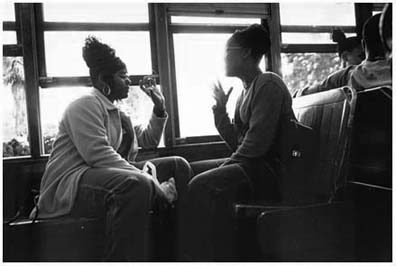
Award
winning photographer,
Juanita Richeson shares with us her TOP tips for success
I came to photography late. Although both of my parents were photographers,
they died when I was young and it never occurred to me to pursue photography
as a career. I pursued a business bachelor's degree, managed bookstores
and worked as a free-lance arts writer.
After a turbulent personal youth, I found myself stranded in Gainesville,
Florida, a single mother and again managing a bookstore. I decided to
go back to school to obtain an Art History degree and work as an arts
administrator. In my last semester, I took Photo 1 to satisfy my last
studio class requirement. I thought it would be easy.
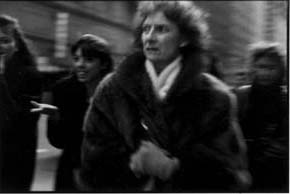 Although
struck by lightning is a cliché, that's what happened to me.
From the very first assignment, I knew what I was going to do for the
rest of my life. Since 1991, I have worked on photography every day.
As I was confident in my knowledge of Art History, I was ignorant about
photography's technical applications. Although
struck by lightning is a cliché, that's what happened to me.
From the very first assignment, I knew what I was going to do for the
rest of my life. Since 1991, I have worked on photography every day.
As I was confident in my knowledge of Art History, I was ignorant about
photography's technical applications.
I moved to California and began taking classes at Santa Monica College,
a school strong in technical training. I also began an MFA program,
but quickly decided I didn't want to teach and also that my life history
had made me either too certain or too stubborn to continue to talk rather
than do.
This decision may have slowed my career initially, but it accelerated
my artistic growth. I began a number of extended conceptual documentary
projects that freed me to ask myself who I really was as an artist.
I asked cops and gang-bangers to make art for me, strangers on the street
who may have thought I was a little crazy. I followed strangers on the
streets of London, Edinburgh, Glasgow and the Hebrides and photographed
them as they used, really used a famous product, Harris Tweed. I photographed
visitors to amusement parks in the midst of their loneliness in crowds
and documented their human attempts to connect with those around them,
familiar, yet unknown. My education came from doing it over and over
again, often wrongly, and waiting, accumulating work for six years before
I tried to show anywhere. I wanted to be sure it was true to my beliefs,
not a response to what someone else had told me to do.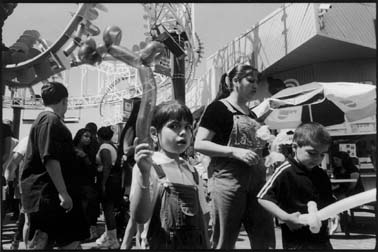
In 1997, I entered the New Photography Show at the Los Angeles County
Fair and won 2nd place. By that time, I had created a massive project
about the LAPD and was starting to think about showing it. I became
involved in a two-year negotiation with the LAPD, at all levels of the
organization, about expanding it into a Community Outreach project.
But the negotiations stalled.
Fortunately, I had been working on other projects at the same time and
in 1999, I began to seek venues for my work. I joined organizations,
I went to shows, and I began promoting other projects. I won awards
and when I did, I promoted them by sending out announcements. I developed
a mailing list, went to portfolio reviews, sent Christmas cards and
created a web site. But most importantly, I continued to do new work
based on issues outside the world of art photography. I was generous
with my photos, some of the most serious conflicts I have encountered
were resolved by giving someone a photo.
In the last year, I have been in more than 30 juried shows, many of
them national, and won several awards. The following list may be useful
to you, I wish I had started many of them sooner.
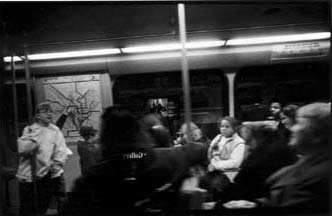
Titles:
"St. Charles, New Orleans"
"Plenty,
NYC," / 2003 Women's Festival, jried by Ruth Weisberg, Dean , Fine
Arts, USC, The Second City Council, Long Beach, Ca
The
Big Wheel Series
Bethesda
International Photography Competition, juried by Philip Brookman, Senior
Curator of Photography Corcoran Gallery of Art, Fraser Gallery, Bethesda,
MD
You
can view more of Juanita Richeson's work at:
www.womeninphotography.org/photoprofile/juanitaricheson
Juanita
Richeson, WIPI Archive Gallery #12
Skates,
Invitation card, kitsch & klick
Outline
for Getting Your Work Shown
I. Be talented. Have well-developed projects. More substance
than style.
Don't pander. Believe what you are doing matters.
II. Have knowledge of what came before you‹you might
not be so special. Art
history will inform the decisions you make in ways you may only
realize
yours later.
III. Know what other people are doing now-galleries, periodicals,
on-line
etc. Don't buy into a trend, but recognize the zeitgeist. Look for
clues for
both your unique perspective and your place in the world community.
IV. Examine your motives for doing work‹money, fame
or art. All are valid,
but have their own set of goals, strictures, and etiquette.
V. Don't whine about not being able to afford producing work
that looks
good (professional) - other people do and it's a cruel world. Nobody
cares
how strapped you are.
VI. Develop extensive mailing lists and send out promos often.
Alternate
announcements and less career-specific. Send out Valentines, Mother's
Day
photos and a card for National Library week - I love librarians.
VII. Research the best markets for your specific style. This
seems
obvious, but artists waste a lot of time and money by not doing
their
homework.
VIII. Don't look for a Mommy or Daddy. Anyone who is really
succeeding
doesn't have time to hold your hand.
IX. Be humble. There are a lot of great photographers out
there. You're
competing with them. All you can do is hope you're able to work
harder and
smarter. And hang in there longer than you think it will take.
X. Build a CV, good shows, established jurors. Look for ways
to show your
work as often as you can in quality locations. This includes restaurants,
libraries, and great looking up-market businesses. Write press releases
about your shows and send them out.
|
XXI.
Be persistent but not obnoxious. Let people get to know you. Keep
it
light.
XII. Research the background, recent accomplishments of
members of the arts
community you admire and send them congratulations. Go see their
shows,
read their books, bring up specifics when you run into them.
IV. Be creative with your promo pieces; hand-made beautiful
pieces with
handwritten notes make and impact. People keep them.
XV. Show nationally as much as you can.
XVI. Don't ever stop working on something new. It will
keep you sane and
give you something new to talk about.
XVII. Always have some give away sample of your work to
give away to
someone. I meet valuable contacts unexpectedly quite often.
XVIII. Don1t invest too much time or hope in any one contact
or
project‹things fall through all the time. All it takes is
the person at the
top to say no. Have backup plans and projects.
XIX. Educate yourself about the world in general. It will
resonate in your
work and in 20 years will continue to accrue value. And it will
get you
outside your frequently frustrated lack of a control position.
XX. Be professional: Punctual, organized, and dependable.
XXI. Volunteer in organizations you identify with. Donate
work for
fundraisers. It's good Karma and people talk.
XXII. Know the law, file copyright, be optimistic but not
gullible.
Network with other photographers to root-out scam artists.
XXIII. Assume it could take you at least ten years to become
established.
Find a rich benefactor or maybe an art critic. It's worked for
centuries.
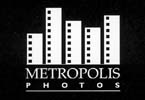
All Images
© Juanita Richeson
Metropolis
Photos Los Angeles
www.MetropolisPhotos.com
top
|
|
![]()
![]()
 GETTING
WORK SHOWN - by
photographer Juanita Richeson
From the very first assignment, I knew what I was going to do for the rest
of my life. Since 1991, I have worked on photography every day. As I was confident
in my knowledge of Art History, I was ignorant about photography's technical applications.
Award winning photographer Juanita Richeson shares her TOP tips for success: Be
talented. Have well-developed projects. More substance than style. Don't pander.
Believe what you are doing matters.
GETTING
WORK SHOWN - by
photographer Juanita Richeson
From the very first assignment, I knew what I was going to do for the rest
of my life. Since 1991, I have worked on photography every day. As I was confident
in my knowledge of Art History, I was ignorant about photography's technical applications.
Award winning photographer Juanita Richeson shares her TOP tips for success: Be
talented. Have well-developed projects. More substance than style. Don't pander.
Believe what you are doing matters.